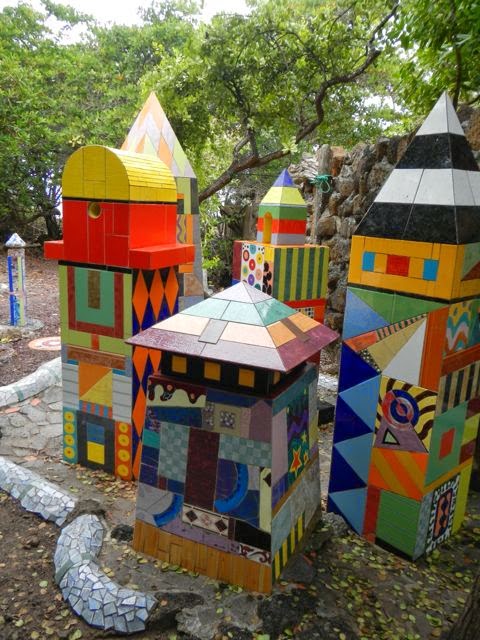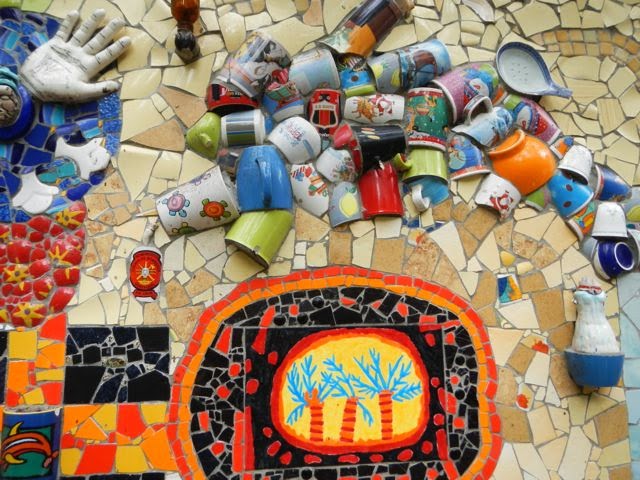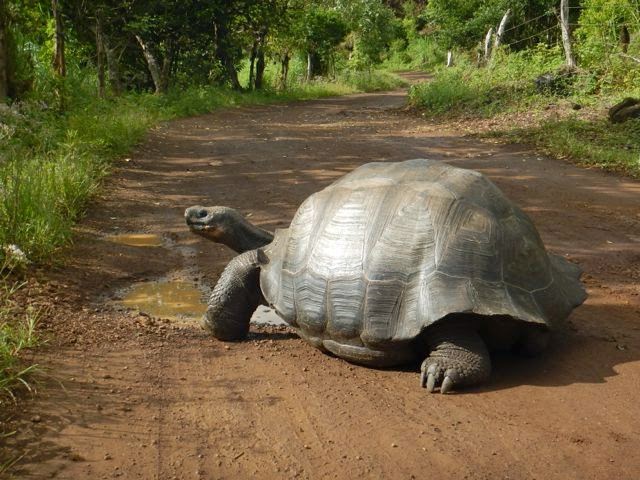 |
| Road Hog |
The climate changes maybe five times in a ten minute drive. The stars light up the black night sky when you go to dinner, and after a quick meal, showers of rain, as our guide Sandy calls them, are at work when you walk back to the tent. We dress damp, and wash underwear tho’ it takes two days to dry. But it’s life at it’s basic. No fuss. No muss. Just be in the moment. It’s quiet. No cars. Only pickup trucks are allowed for tourism and police, and they have large numbers on their roofs. Yes, giant buses – or least buses too large for the roads – are given some opportunities to cart tour groups on this island. They are reminders there is the world of making money out there, the terrible human footprint. And at the airport and on the docks, police roam with drug dogs. Apparently they make many arrests at both places.
Today was another Tortoise Day because we are on the island with the most tortoises. They appear everywhere moving at a snail’s pace and chewing bright green grasses as they go. Caramba! if they find a guava tree. That’s the chocolate truffle of their comestibles. Shells of pink guavas in the grass signal that a tortoise has passed this way recently.
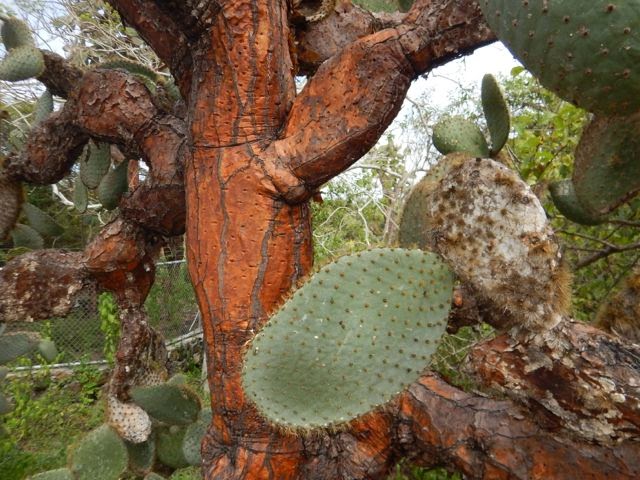 |
| Opuntia cactus |
 |
| Learning Life |
In the beginning of today, we passed three giant tortoises in the long muddy driveway of our Safari Camp. Yes there are wire fences, but basically to keep a few friendly cows in place. The tortoises plow right on through them and the long wet elephant grasses that stay moist in the rain. Our guide Sandy is a poop expert, she told us, having worked at Charles Darwin Research Center on Santa Cruz island for many years before becoming a guide. We were starting the day there absorbing more turtle knowledge than one would ever need.
When tortoises lay their eggs on various islands, the Galapagos Patrol finds them and brings them to one of the centers. These giant reptiles do not sit on or nourish their eggs and babies, therefore survival rates would be low. In the various Darwin centers the eggs are incubated and babies hatched. Each is given a number 1-20 which is painted blue on it’s shell. Tourists cannot interrupt the incubation life, but we were able to wander through the nursery, which is a confined area with plenty of prickly pear Optima cactus and other arid trees and scrub. The various stages of tortoise childhood are divided into large open pens. When the tortoises reach four years,(about 10-12 inches long) they are put into a more true environmental area with obstacles where climbing, flipping over, falling, etc. are confronted and they must learn how to survive. Then they are released back into the island where they were birthed, so the populations of Giant Galapagos Tortoises never fails. There are 5000 tortoises related to one female who survived the volcanic eruption thousands of years ago. That female’s gene lives on.
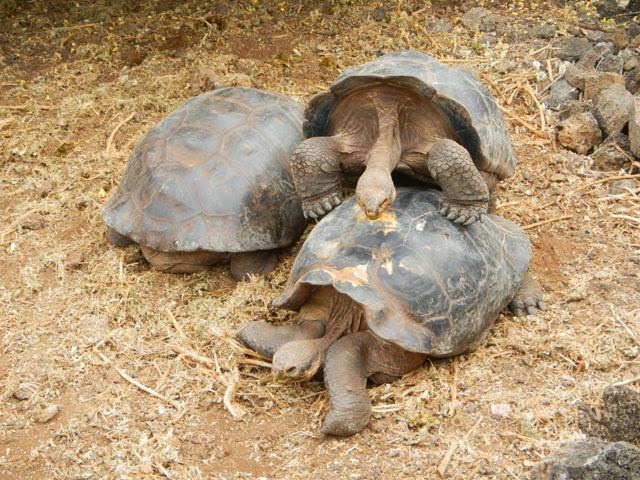 |
| Menage a’ Trois |
 |
| Diego on to another |
Although they have few enemies, giant tortoises who contact disease do not live long and they kill each other. When I asked if there is a patrol who goes around even on private ranches filled with these reptiles making sure they are safe and healthy, the answer was no. If a young tortoise falls in a crevice, he needs to learn how to get out. Here we go. Survival of the fittest, a la Darwin.
There are heroic stories – like Lonely George. For a hundred years, George wandered the island of Espanola and never found a female he liked. He was brought into the center for a few decades as caretakers searched for the most attractive females (much smaller than males), but George was never successful in producing offspring. It was tragic because he apparently had been from the line that Charles Darwin encountered when he first visited Galapagos and catalogued the many finches based on their beaks. George died in 2012.
 |
| Oops, baby |
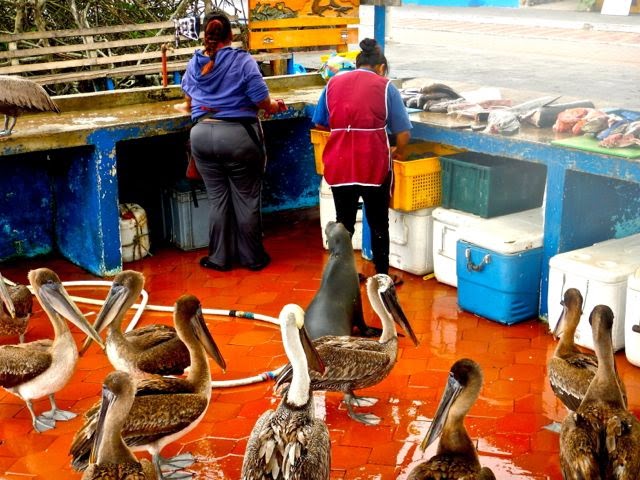 |
| Local Fish Market Customers |
Then there is Diego, a long necked – saddle backed Galapagos Tortoise. Ugly as a goblin but this guy is responsible for 80 per cent of the child tortoises (1500) on Espanola Island (making up for poor George’s failures). We saw Diego, busy at work finishing with one chica and then moving on to another. This breed has an uncanny ability to stand up on their four legs so they are about 12-18 inches of the ground, to move with some speed, and their necks are extremely long and mostly outside their shell. Now just not to leave anyone out, there was another corral where it looked like a bunch of the boys (about 12) were whooping it up in a Saloon – three of them were indulging in a menage a’ trois. Something for everyone, I was told they didn’t know the difference?
From here we drove about a half hour to what is called Garapatera Beach (named for the birds that pick ticks off of animals) and which was supposed to have flamingos in the lagoon. No flamingo. It took a half kilometer walk on a man-made path (to stop people from getting lost in the shrubs and palo santos trees) to the very soft white sandy beach. Sandy explained that this rare beach was not made from sand but from the poop of the Parrot Fish which consumes coral and poops it out. Must have taken a few decades. Yes we walked on it barefooted (so smooth) to the turquoise water.
Sandy also pointed out to us an apple tree which is delicious for the Tortoises but deadly for man. It produces a tiny dark green apple (about the size of a crab apple) and if you touch it or ingest it, and you don’t get the stomach pumped immediately, it’s death. So goes the law of the jungle. Some things are just for God’s creatures great and small. Galapagos tourists are trained not to touch anything – not a tree, not an animal, not a grass blade. And to stick a piece of white coral in your trousers thinking you will get it off the island is also deadly. You will be discovered and you will be sent to jail.
We had time to shop in the small town and visit not only the funny fish market where pelicans and sea lions were irritating customers and a school whose outside walls were adorned with mosaics and broken ceramics made into scenes. A woman who died of cancer recently, left the little art filled park for children to enjoy.
 |
| A Giant Tortoise For Sure |
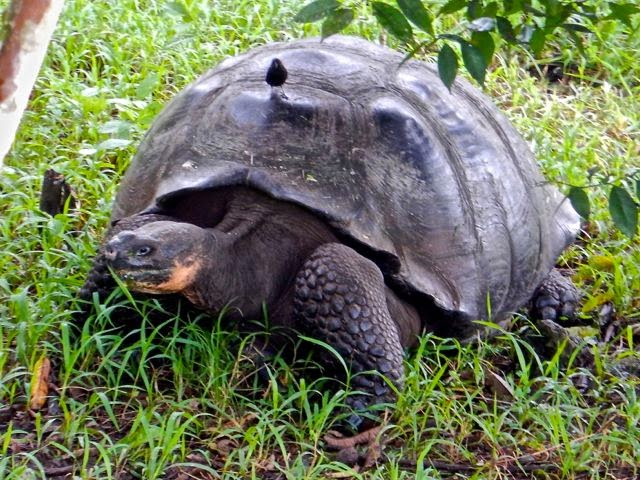 |
| Grumpy Dome backed giant |
Finally, once more in the dripping drizzle, we stopped by another private farm which opened its arms to the gigantic tortoises (the dome shaped ones, mostly). These are the big guys, some as tall as my waist, and their personalities began to speak to us. We dug into our galoshes and said no to umbrellas and trod through the mud to see what those big slow moving rocks were doing. They will make a grrrrrunt noise if they don’t want to be disturbed, and most had probably had it after the buses of kids on summer break had come through. The biggest grunted at us. We too were tortoised out so headed back to the Safari Camp, mist and rain following us, and were given a cooking lesson in how to make real Ecuadorian serviche and locro, the common soup made of various potatoes, cheese and avocado. Tonight, finally, I slept as rain drops and moth dancing on the tents sang me to sleep. Amen.
 |
| Poop beach |


